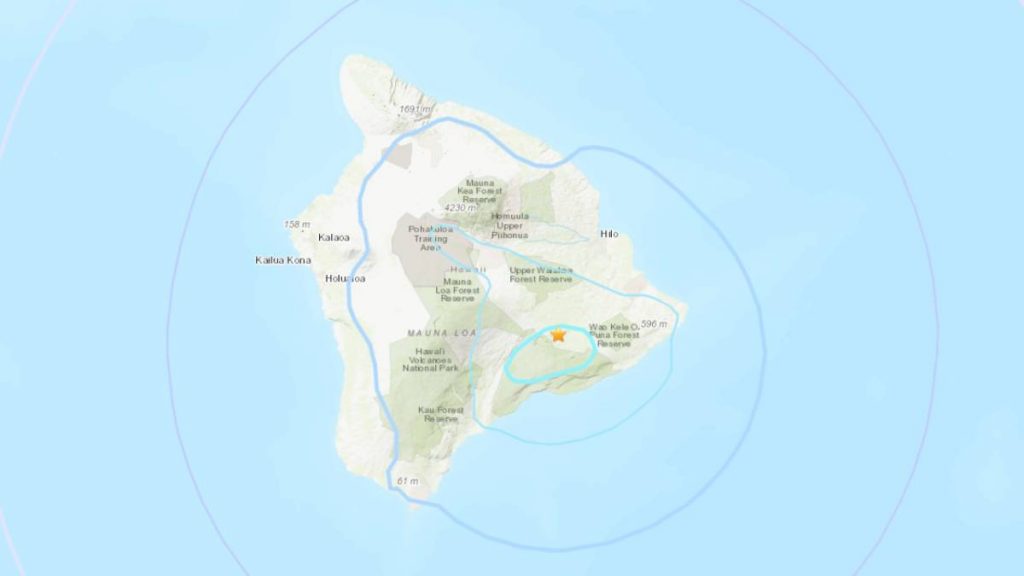Hawaii 4.4-magnitude quake in Hawaii Near Volcano Island ; no tsunami threat
On Monday, December 4th, 2023, a 4.4-magnitude earthquake struck the Island. The quake was felt across the island, but fortunately, there was no threat of a Hawaii tsunami. According to the U.S. Geological Survey, the earthquake’s epicenter was located about 8 miles southwest of Volcano Village at a depth of approximately 7 miles.
Hawaii Quake ,Tsunami Map

Image by : The U.S. Geological Survey
Despite the relatively minor magnitude of the earthquake, it is a reminder of Hawaii’s volcanic activity and the potential for larger earthquakes in the future. In recent years, island has experienced several significant earthquakes, including a 6.9-magnitude earthquake in May 2018 that caused widespread damage on Island.
Despite the lack of major damage, the earthquake did cause some disruption to daily life on the island. Many residents reported feeling the quake, with some describing it as a sharp jolt followed by a rolling motion. Some schools and businesses temporarily closed as a precaution,
Hawaii-Island is no stranger to seismic activity, as it sits atop a network of active volcanoes and fault lines. In fact, the island is home to Kilauea, one of the most active volcanoes in the world. While earthquakes are a common occurrence in the area, they can still be a cause for concern, particularly if they occur near populated areas.
Hawaii-Quake : USGS-HVO Interactive Earthquake Map
In conclusion, the 4.4-magnitude earthquake that rattled Island on October 12, 2021, caused some disruption to daily life on the island, but fortunately, there was no significant damage or tsunami threat. While earthquakes are a common occurrence in the area, it is important for residents to remain aware of the possibility of aftershocks and take precautions to ensure their safety in the event of any further seismic activity.
It is always important to be prepared for earthquakes and other natural disasters. If you live in a seismic zone, make sure you have an emergency plan in place and have stocked up on supplies such as non-perishable food, water, and first aid supplies. Stay safe and stay prepared.
Historical Hawaii Tsunami Records: 85 Waves That Shaped Hawaii’s Destiny
While Hawaii may have become a paradise synonymous with serene beaches and azure waters, its history reveals a tumultuous relationship with destructive waves. The earliest recorded tsunami struck in 1813 or 1814, setting the precedent for a series of impactful events. The most devastating occurred in 1946, claiming 173 lives in its wake.
In a twist of fate, a tsunami warning on February 27, 2010, prompted the evacuation of Waikiki, showcasing the island’s preparedness. Subsequent scares, like the one in 2012 after a seismic event near British Columbia, saw the authorities taking precautionary measures. Fortunately, the expected 7-foot waves turned out to be around 2.5 feet.
Hawaii has witnessed several false alarms, including one in 1994, as acknowledged by geophysicist Brian R. Shiro. However, historical records also attest to the real and destructive power of tsunamis, notably in 1975, claiming lives and causing significant damage.
The most catastrophic wave struck on April 1, 1946, following a 7.4 Richter Scale earthquake in the Aleutian Islands. Racing across the ocean at 500 miles per hour, the 55-foot waves left Hilo devastated. The aftermath saw 173 lives lost, 163 injured, and extensive property damage, with an estimated cost of $25 million. Witnesses recounted streets, homes, and storefronts submerged, and victims carried out to sea by receding waters.
Maui, too, bore the brunt, with 14 fatalities, 550 displaced, and 77 structures destroyed. The 1946 tragedy prompted the establishment of the Tsunami Warning System, a crucial step to protect Hawaii and Pacific nations from future inundations.
The Phenomenon of Megathrust Earthquakes
Megathrust earthquakes stand out as some of the most powerful seismic events on Earth. These earthquakes occur at subduction zones, where an oceanic tectonic plate is thrust beneath a continental plate. The persistent collision and friction between these massive plates result in the accumulation of stress. Eventually, this stored energy is released in the form of a colossal earthquake.
One such remarkable event was the Chignik earthquake, which rattled the coast of Alaska on July 28, 2021. With a magnitude of 8.2, it became the seventh-strongest earthquake in U.S. history. This seismic event occurred 32 kilometers beneath the ocean depths, underscoring the raw power generated by the relentless movement of tectonic plates
The historical records, documented in George Pararas-Carayannis’s “List of Tsunamis in the Hawaiian Islands,” reveal that at least 85 tsunamis have disrupted Hawaiian tranquility since the early 19th century. Of these, 15 caused significant damage, with only four originating near Hawaii. Notably, in 1837, a tsunami claimed 62 lives in Hilo, luring people onto the exposed reef with the promise of abundant fish, only to drown when the 20-foot waves struck.
Hawaii’s relationship with tsunamis is a complex tale of resilience, preparedness, and the enduring impact of nature’s formidable forces. As the islands continue to evolve and adapt, the historical records serve as a poignant reminder of the need for vigilance and proactive measures in the face of potential threats from the Pacific’s depths. The islanders’ ability to navigate the delicate balance between the allure of paradise and the dangers of the deep offers lessons in resilience for coastal communities worldwide.
Also Check : Probate and Family Court Boston : Nominees

